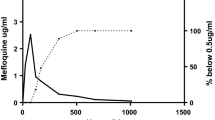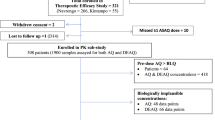Abstract
Objective
The combination of chloroquine and methylene blue is potentially effective for the treatment of chloroquine-resistant malaria caused by Plasmodium falciparum. The aim of this study was to investigate whether methylene blue influences the pharmacokinetics of chloroquine.
Methods
In a randomized, placebo-controlled, parallel group design, a 3-day course of therapeutic oral doses of chloroquine (total 2.5 g in male, 1.875 g in female participants) with oral co-administration of placebo or 130 mg methylene blue twice daily for 3 days was administered to 24 healthy individuals. Chloroquine, desethylchloroquine, and methylene blue concentrations were determined by means of HPLC/UV or LC/MS/MS assays in whole blood, plasma, and urine for 28 days after the last dose.
Results
During methylene blue exposure, the area under the chloroquine whole blood concentration–time curve normalized to body weight (AUC0-24 h/BW) yielded a trend of reduction (249±98.2 h μg l−1 kg−1 versus 315±65.0 h μg l−1 kg−1, P=0.06). The AUC0-24 h/BW of desethylchloroquine was reduced by 35% (104±40.3 h μg l−1 kg−1 versus 159±66.6 h μg l−1 kg−1, P=0.03), whereas the metabolic ratio between chloroquine and desethylchloroquine remained unchanged (2.25±0.49 versus 1.95±0.42, P=0.17). The renal clearance of chloroquine and the ratio between chloroquine in whole blood and plasma remained unchanged (P>0.1).
Conclusion
Oral co-administration of methylene blue appears to result in a small reduction of chloroquine exposure which is not expected to be clinically relevant and thus represents no concern for further development as an anti-malarial combination.



Similar content being viewed by others
References
Snow RW, Craig M, Deichmann U, Marsh K (1999) Estimating mortality, morbidity and disability due to malaria among Africa’s non-pregnant population. Bull World Health Organ 77:624–640
Ducharme J, Farinotti R (1996) Clinical pharmacokinetics and metabolism of chloroquine. Focus on recent advancements. Clin Pharmacokinet 31:257–274
Trape JF (2001) The public health impact of chloroquine resistance in Africa. Am J Trop Med Hyg 64:12–17
Wellems TE, Plowe CV (2001) Chloroquine-resistant malaria. J Infect Dis 184:770–776
Winstanley P (2003) The contribution of clinical pharmacology to antimalarial drug discovery and development. Br J Clin Pharmacol 55:464–468
Müller O, Traore C, Kouyate B, Becher H (2003) Malaria morbidity, treatment seeking behaviour, and mortality in a cohort of young children in rural Burkina Faso. Trop Med Int Health 8:290–296
Guttmann P, Ehrlich P (1891) Über die Wirkung des Methylenblau bei Malaria. Berlin Klin Wochenschr 28:953–956
Vennerstrom JL, Makler MT, Angerhofer CK, Williams JA (1995) Antimalarial dyes revisited: xanthenes, azines, oxazines, and thiazines. Antimicrob Agents Chemother 39:2671–2677
Peter C, Hongwan D, Küpfer A, Lauterburg BH (2000) Pharmacokinetics and organ distribution of intravenous and oral methylene blue. Eur J Clin Pharmacol 56:247–250
Chongtham DS, Phurailatpam J, Singh MM, Singh TR (1997) Methaemoglobinaemia in nitrobenzene poisoning. J Postgrad Med 43:73–74
Färber PM, Arscott LD, Williams CH, Becker K, Schirmer RH (1998) Recombinant Plasmodium falciparum glutathione reductase is inhibited by the antimalarial dye methylene blue. FEBS Lett 422:311–314
Meierjohann S, Walter RD, Müller S (2002) Regulation of intracellular glutathione levels in erythrocytes infected with chloroquine-sensitive and chloroquine-resistant Plasmodium falciparum. Biochem J 368:761–768
Ginsburg H, Famin O, Zhang J, Krugliak M (1998) Inhibition of glutathione-dependent degradation of heme by chloroquine and amodiaquine as a possible basis for their antimalarial mode of action. Biochem Pharmacol 56:1305–1313
Projean D, Baune B, Farinotti R, Flinois JP, Beaune P, Taburet AM, Ducharme J (2003) In vitro metabolism of chloroquine: identification of CYP2C8, CYP3A4, and CYP2D6 as the main isoforms catalyzing N-desethylchloroquine formation. Drug Metab Dispos 31:748–754
Gustafsson LL, Walker O, Alvan G, Beermann B, Estevez F, Gleisner L, Lindström B, Sjöqvist F (1983) Disposition of chloroquine in man after single intravenous and oral doses. Br J Clin Pharmacol 15:471–479
DiSanto AR, Wagner JG (1972) Pharmacokinetics of highly ionized drugs II: methylene blue—absorption, metabolism, and excretion in man and dog after oral administration. J Pharm Sci 61:1086–1090
Masereeuw R, Russel FG (2001) Mechanisms and clinical implications of renal drug excretion. Drug Metab Rev 33:299–351
Hellgren U, Kihamia CM, Mahikwano LF, Bjorkman A, Eriksson O, Rombo L (1989) Response of Plasmodium falciparum to chloroquine treatment: relation to whole blood concentrations of chloroquine and desethylchloroquine. Bull World Health Organ 67:197–202
Minzi OMS, Rais M, Svensson JO, Gustafsson LL, Ericsson Ö (2003) High-performance liquid chromatographic method for determination of amodiaquine, chloroquine and their monodesethyl metabolites in biological samples. J Chromatogr B Analyst Technol Biomed Life Sci 783:473–480
Breitkreutz J (2000) Leakage of enteric (Eudragit L)-coated dosage forms in simulated gastric juice in the presence of polyethylene glycol. J Control Release 67:79–88
Schirmer RH, Coulibaly B, Stich A, Scheiwein M, Merkle H, Eubel J, Becker K, Becher H, Müller O, Zich T, Schiek W, Kouyate B (2003) Methylene blue as an antimalarial agent. Redox Rep 8:272–276
Müller O, Traore C, Kouyate B (2003) Clinical efficacy of chloroquine in young children with uncomplicated falciparum malaria—a community-based study in rural Burkina Faso. Trop Med Int Health 8:202–203
Reece M, Prawitt D, Landers J, Kast C, Gros P, Housman D, Zabel BU, Pelletier J (1998) Functional characterization of ORCTL2—an organic cation transporter expressed in the renal proximal tubules. FEBS Lett 433:245–250
Tiberghien F, Loor F (1996) Ranking of P-glycoprotein substrates and inhibitors by a calcein-AM fluorometry screening assay. Anticancer Drugs 7:568–578
Pauli-Magnus C, Lacayo CI, Kroetz DL (2001) Antimalarial drugs are not substrates of human P-glycoprotein. Clin Pharmacol Ther 69:P76
Dresser GK, Spence JD, Bailey DG (2000) Pharmacokinetic-pharmacodynamic consequences and clinical relevance of cytochrome P450 3A4 inhibition. Clin Pharmacokinet 38:41–57
Martinez C, Albet C, Agundez JA, Herrero E, Carrillo JA, Marquez M, Benitez J, Ortiz JA (1999) Comparative in vitro and in vivo inhibition of cytochrome P450 CYP1A2, CYP2D6, and CYP3A4 by H2-receptor antagonists. Clin Pharmacol Ther 65:369–376
Ette EI, Brown-Awala EA, Essien EE (1987) Chloroquine elimination in humans: effect of low-dose cimetidine. J Clin Pharmacol 27:813–816
McElnay JC, Mukhtar HA, D’Arcy PF, Temple DJ, Collier PS (1982) The effect of magnesium trisilicate and kaolin on the in vivo absorption of chloroquine. J Trop Med Hyg 85:159–163
Acknowledgements
This study was supported by DSM Fine Chemicals Austria, Linz, Austria. We thank Mrs. Dorothea Schimpf, MS, for preparing the study medication; Mrs. Brigitte Tubach for study support; and Mrs. Andrea Deschlmayr and Mrs. Magdalena Longo for their excellent technical assistance. The study was approved by the ethics committee of the Medical Faculty of the University of Heidelberg, and was conducted at the Department of Internal Medicine VI, Clinical Pharmacology and Pharmacoepidemiology in accordance with the Declaration of Helsinki, as amended in Somerset West 1996, and the specific legal requirements in Germany.
Author information
Authors and Affiliations
Corresponding author
Rights and permissions
About this article
Cite this article
Rengelshausen, J., Burhenne, J., Fröhlich, M. et al. Pharmacokinetic interaction of chloroquine and methylene blue combination against malaria. Eur J Clin Pharmacol 60, 709–715 (2004). https://doi.org/10.1007/s00228-004-0818-0
Received:
Accepted:
Published:
Issue Date:
DOI: https://doi.org/10.1007/s00228-004-0818-0




